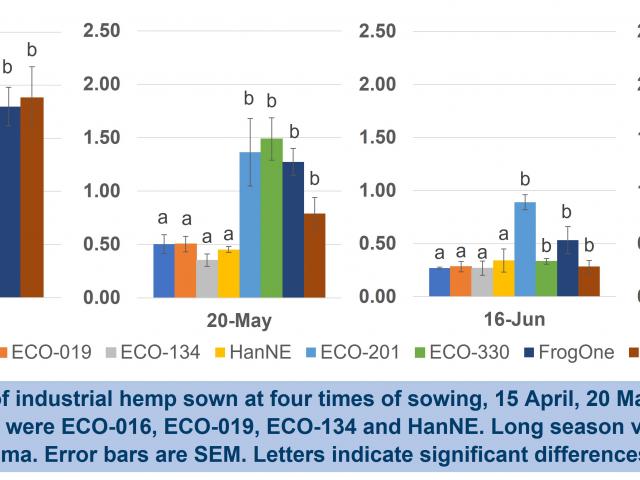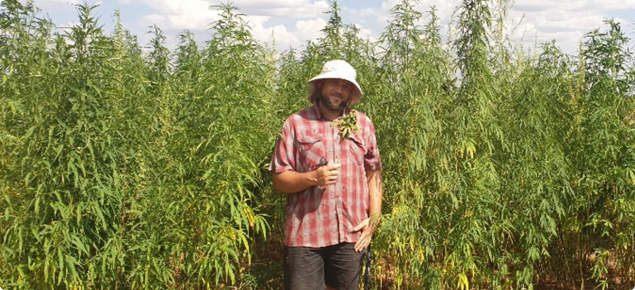Scientists are researching suitable varieties and the best time to sow in the tropical and Mediterranean WA. This world first research is looking to develop IH as a fodder for livestock, through early grazing and conserved fodder. Development also includes working with IH processors to develop markets for fibre based products such as hempcrete, insulation and fibreboard building products.
Key messages
- In Western Australia, industrial hemp (Cannabis sativa) is defined as cannabis where leaves and flowering heads do not contain more than 1.0% of Tetrahydrocannabinol (THC).
- Diversity of industrial hemp genotypes has wide agronomic application and end uses. Varieties could be split into two maturity types: early maturing 60-65 days crop and long season more than 110 days crop.
- Industrial Hemp (IH) for grain yield is suited to planting March to May in the Ord River irrigation area.
- Later planting is not recommended for grain production but may have utility for growing fibre or cover cropping.
Introduction
The first industrial hemp trial for grain yield was conducted at Kununurra in 2021. The aim was to investigate flowering and grain yield of various genotypes response to sowing at this latitude.
Multiple end-uses and agronomic potential of industrial hemp have potential to diversify rotations and markets in the region and could be grown at a range of sowing times for the different uses. Most industrial hemp research and production in Australia occur at higher latitudes (cooler climates) than in Kununurra and during summer when days are longer (e.g. latitude at Kununurra of 15°S compared to Hobart 42°S). However, the diversity in hemp genetics and end-uses mean that there is a wide range of maturity lengths and growth habits available.
What we did
Eight industrial hemp varieties were sown over four dates at the Frank Wise Institute of Tropical Agriculture, these were 15 April, 20 May, 19 June and 14 July 2021. The paddock was fallowed in 2020 and cropped to chickpea in 2019. They were planted to achieve a target plant density of 630,000 plants/ha (60.3 plants per m2), watered-up post-sowing and then irrigated on a 14-day cycle. Nitrogen (30kg/ha) and boron (2 kg/ha) was top dressed approximately 30 days after planting.
| Sowing date | Days to harvest (harvest date) | |
|---|---|---|
| Early varieties | Long season varieties | |
| 15 April | 61 (15 June) | 99 (23 July) |
| 20 May | 64 (23 July) | 96 (24 Aug) |
| 16 June | 70 (25 Aug) | 110 (4 Oct) |
| 14 July | 79 (1 Oct) | 103 (25 Oct) |

Varieties could be spilt into two maturity types suited for different agronomic and end uses
Early maturing varieties
Early maturing varieties were harvested 60-65 days after planting and were only suited to grain production. They had shorter and less branching canopy growth, and more determinate flowering duration. They were quick to flower. They produced similar grain yields for all sowing dates trialled therefore having a longer planting window than long season varieties if producing grain (see Table 1).
Flowering of early maturing varieties was driven by growing degree days when sown 15 April to 19 June. Temperature to flowering increased for later plantings, coinciding with lengthening day-length in July.
Long season varieties
Long season varieties were a 100-110 day grain crop producing more biomass, were taller, growing to above 2 metres and had later flowering that was driven by day length. Grain yield was higher than early varieties for April and May plantings but decreased with later plantings (see Table 1).
Longer days experienced by plants sown 14 July caused the plants to continue vegetative growth, increasing biomass yield but without ever flowering, eventually the experiment was terminated in late October. Suggesting that later sown (after June) long season varieties could be grown and harvested for fibre.
Recommendation
From this work the following is recommended:
- Growers using varieties in this trial should only plant between mid April and mid May.
- The varieties that provide the highest grain yields in this trial have are:
- Eco-201
- Eco-330
- Frog 1
- Yuma
Differences between the yields of these four varieties are not significant at these recommended seeeding dates.
Future research
This is a 3 year project that commenced in 2021. DPIRD is trialling IH in Kununurra for the next 2 years as part of the AgriFutures National Industrial Hemp Variety Trials. We are investigating additional end-use for industrial hemp as feed for livestock and conducting value chain analysis for industrial hemp in collaboration with the Northern Territory Department of Industry, Tourism and Trade.
Acknowledgements
Thank you to Dr Omid Ansari (Ecofibre) for provision of ECOfibre lines and his agronomic advice. The Hemp corporation for supplying seed of Yuma and HanNE, and David Campbell for supplying seed of FrogOne (Karingal Pastoral Co).
The trial would not have been a success without DPIRD’s Eli Staugas for technical support; Jack and Jodie (Northern Australia Crop Rresearch Alliance) for help with seeding; Mark, Shayne and Gerrard for managing the trial area; and Helen Spafford and Penny Goldsmith (OrdCo) with pest identification.

